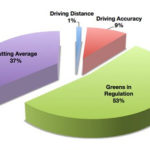Stableford Rules
The Stableford System, developed by Dr. Frank Barney Gorton Stableford in 1931, is a scoring system in which the final score is not the stroke total, but the total points earned for scores on each individual hole. Unlike traditional golf scoring methods, the objective is to have the highest score. The number of points awarded on […]
Read MoreDefining the Teeing Ground
According to the USGA the definition of the teeing ground is: “The starting place for the hole to be played. It is a rectangular area two club-lengths in depth, the front and the sides of which are defined by the outside limits of two tee-markers. A ball is outside the teeing ground when all of […]
Read MoreDid You Address the Ball?
The USGA says “A player has “addressed the ball” when he has grounded his club immediately in front of or immediately behind the ball, whether or not he has taken his stance.” This means you can take a stroke and strike the ball without ever actually addressing the ball. There are already a few times […]
Read MoreWhat To Do If You Lost Your Ball
According to Rule 27-1 from the USGA you have five minutes to search for your ball. This time starts from when you actually start searching for the ball. If you do not find the ball within five minutes the ball is lost whether you find it after the five minutes or not. You must play a […]
Read MoreNot so Hazardous Water
According to the USGA, “‘Casual water’ is any temporary accumulation of water on the course that is not in a water hazard and is visible before or after the player takes his stance. Snow and natural ice, other than frost, are either casual water or loose impediments, at the option of the player. Manufactured ice […]
Read MoreHow Many “Strokes” did You Actually Take?
The USGA defines a stroke as “the forward movement of the club made with the intention of striking at and moving the ball, but if a player checks his downswing voluntarily before the clubhead reaches the ball he has not made a stroke.” This means you do not actually have to touch the ball for […]
Read MoreRules: Winter Rules
Many people just start using “Winter Rules” whenever they deem – but did you know it’s actually a rule accounted for in the Rules of Golf – Appendix I Section? Here is the rule, make sure when you are playing golf this winter that the course has invoked Appendix I – 4b. Course Conditions – […]
Read MoreNew and Revised Decisions on the Rules Of Golf
The USGA and the R&A have recently released a new Decisions on the Rules of Golf 2014-2015. If you are not familiar with the Decisions on the Rules book – it is a book about 10 times the size of the Rules of Golf book and contains 1,200 entries addressing specific situations under the Rules […]
Read MoreRule 23 – Loose Impediments
We have all heard the term “loose impediments”, but what is a loose impediment? This can be a tough answer. A good rule of thumb is that a “loose impediment” is anything natural, as opposed to a “movable obstruction” which is artificial (or man-made). Some examples of loose impediments are: Gravel Sea Shells Fruit Skins […]
Read MoreRule 12 – Searching For And Identifying Ball
We’ve all hit a golf ball that we had to search for at one point or another. I have listed out some situations and how to proceed under the rules in those situations – so you’re not penalized two strokes under Rule 12. A player is not necessarily entitled to see his ball when making […]
Read More















